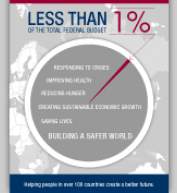- Agriculture and Food Security
- Democracy, Human Rights and Governance
- Economic Growth and Trade
- Education
- Environment and Global Climate Change
- Frontiers in Development
- Gender Equality and Women's Empowerment
- Global Health
- Science, Technology and Innovation
- Water and Sanitation
- Working in Crises and Conflict
Building Resilience

In 2011, the worst drought in 60 years put more than 13.3 million people into crisis in the Horn of Africa.
The international community devoted $1.5 billion in a life-saving response that provided access to food, water and basic health services. This was not the first drought, famine and conflict that the region has experienced, and it will not be the last.
|
USAID Assistant Administrator Nancy Lindborg makes the case in the Huffington Post for doing business differently to combat crisis in the Sahel.
|
Tens of millions of people across continents are vulnerable to recurring shocks that chronically devastate whole communities and reverse hard-won development gains. Over the last decade, the United States and the European Union have spent over $9 billion on responding to emergencies in East Africa alone, where recurring shocks combine with chronic poverty, trapping vulnerable communities in cyclical crisis.
USAID is helping to lead an international commitment to building resilience in areas prone to cyclical crisis so that development gains endure and whole livelihoods are not lost with the next shock. This means bringing our relief and development efforts together so that our humanitarian assistance contributes to long-term benefits for local populations even as we save lives.
|
Mercy Corps Director of Policy and Advocacy Jeremy Konyndyk writes in USAID’s Impact Blog on research on the role of conflict in efforts to build resilience in the Horn of Africa.
|
Building resilience supports communities so that they are able to adapt to and recover from shocks and stresses and move forward with enhanced livelihoods. Based on results we have already seen at the community and household levels, USAID is doing business differently – through key operational changes, close coordination with international partners, and support for country-led plans – to bring this approach to scale for countries and regions. Through market-sensitive approaches, acting early in response to early warnings, and bringing our relief and development teams together for joint assessments of local needs, we are investing in solutions that empower populations to move forward.
-
Last year in Somalia, we prioritized innovative approaches to reach people in need, despite having limited access. In Kenya and Ethiopia, our development investments and resilience programming paid off, helping families cope with the effects of the drought and prevented 7.6 million more people from needing emergency assistance.
-
In April 2012, we launched a Global Alliance for Action with African governments and our international development partners to cement a shared commitment to build resilience in areas plagued by constant crisis. Through well-developed plans, local governments are enacting real policy changes as a result.
-
Lessons from our successful response in the Horn are shaping our response to current crisis in the Sahel, where 18.7 million people are currently in need of assistance.
- In both the Horn and the Sahel, we have stood up joint planning teams bringing our relief and development partners together to identify and support mechanisms that can combat chronic vulnerability while meeting immediate needs. These teams are undertaking joint problem assessments; integrating, layering, and sequencing our programming; and closely coordinating with international donor partners for lasting, comprehensive solutions. In the Horn, our team is working to directly benefit 10 million people and ultimately reduce the region’s emergency caseload by one million people by 2017.=
|
Dairy Farmers in Kenya work with USAID to improve production and learn the value of dairy cooperatives. Results: higher incomes and better resilience to absorbing shocks. |
Resilience programming isn’t new – rather, evidence illustrates it is what goes the farthest to enhance livelihoods on the ground. Through leading new international efforts and making key changes to support this goal, USAID is working to build on these results and to apply lessons learned in the Horn and the Sahel to other key areas where shocks and underlying vulnerability drag populations into crisis again and again. We can’t prevent future shocks from occurring, but we can help make them less devastating while ensuring the continuation of long-term growth.






Comment
Make a general inquiry or suggest an improvement.